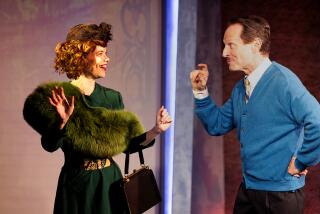Kienholz’s ‘Five Car Stud’ still packs a punch
- Share via
It’s not often that a publicist at the Los Angeles County Museum of Art sends this warning before an advance tour of a new exhibit: You’ll be walking on a dirt floor, so choose your footwear accordingly. But the carpet of dirt on the gallery floor is the least unusual aspect of Edward Kienholz’s “Five Car Stud,” an installation piece depicting four white men pinning down and castrating a black man. It opens to the public Sunday.
For the piece, which was completed in Los Angeles in 1972, last viewed publicly in Germany that year, then kept in storage in the Japanese museum that now owns it, this exhibition is a homecoming. For LACMA and the county government, which helps fund the museum, it is a moment to revisit their own turbulent past.
Kienholz, who died in 1994 and was a key figure in the midcentury Los Angeles art scene, had an instinct for finding graphic ways of confronting social issues. Three years before he started “Five Car Stud,” a 1966 LACMA show of his work was almost shut down by the Los Angeles County Board of Supervisors, which denounced it as pornographic. (The main offender was “Back Seat Dodge ‘38,” a tableau of a young couple amorously wrapped around each other in the back seat of a parked car.) Today it seems quaint that the board ever tried to close down an art exhibit. Nevertheless, LACMA Director Michael Govan and other museum officials visited every supervisor’s office to let them know what was about to be unveiled this weekend.
“Five Car Stud” portrays the kind of violence more likely to have occurred in the first half of the 20th century, mostly in the South, and it stands as a powerful reminder of that shameful history. Although the era of public lynchings was essentially over when Kienholz was creating the piece, the strife of the civil rights era was in full force. “Generally I think of Five Car Stud as symbolic of minority strivings in the world today,” Kienholz wrote at the time. Decades later, it is a reminder of the shameful intolerance of the present as well — consider the brutal attacks on gays, Muslims, the homeless and, yes, blacks, still.
The museum has taken great pains to offer context for what the viewer will see. There is an introductory gallery — sort of an anteroom that must be passed through — with explanatory text about the piece, that period in history, photos of the work in progress and the pages of Kienholz’s manifesto on what he was doing and why he was doing it. Visitors are, of course, free to breeze through without reading any of it. However, as curator Stephanie Barron says, “you need a transition zone” between the sunlit outdoors and the darkened gallery. Only 15 people at a time will be allowed in.
The installation is astonishingly life-size. The 7,500-square-foot gallery looks like a theatrical set made to look like a dirt clearing. Four cars and a pickup truck surround the white men, all wearing rubber masks that Kienholz bought at the Hollywood Magic Shop, standing or kneeling over a black man who lies on the ground, his feet tied, his genitals exposed. A young white boy watches from inside one of the cars. The perpetrators are realistic yet cartoonish. The victim’s torso is an abstraction — a tank of water with the letters of a racial epithet floating disconnected on the rippling surface.
The artist invites viewers to enter the scene, which is illuminated mostly by the cars’ headlights. One is free to stand back or take a closer look, walk around the figures, peer past the ratty pickup truck’s open door, eye a white woman — presumably the companion of the black man — as she covers her face. (Kienholz wrote that she is vomiting.) The sound of Delta blues wafts out of the truck as if from a tinny radio.
At the time “Five Car Stud” was finished — when it would have appeared as shocking to Americans in the throes of civil unrest as the clenched couple in the back seat of a Dodge was to the buttoned-up county supervisors — it was an artwork without a home. It was pulled from an early 1970s London show of Los Angeles artists because it was “ostensibly” — as Kienholz put it — too expensive to ship. A LACMA curator wanted to show the new work as well, but that never happened. Although it’s unfortunate that the piece is resurfacing in the United States only now, it remains a provocative commentary on the fear, anger and pain — both physical and psychological — created by intolerance. Its return was delayed, but it arrives in time to make an impact on the cultural landscape of Los Angeles.
It will be on view through Jan. 15, 2012.
More to Read
A cure for the common opinion
Get thought-provoking perspectives with our weekly newsletter.
You may occasionally receive promotional content from the Los Angeles Times.










